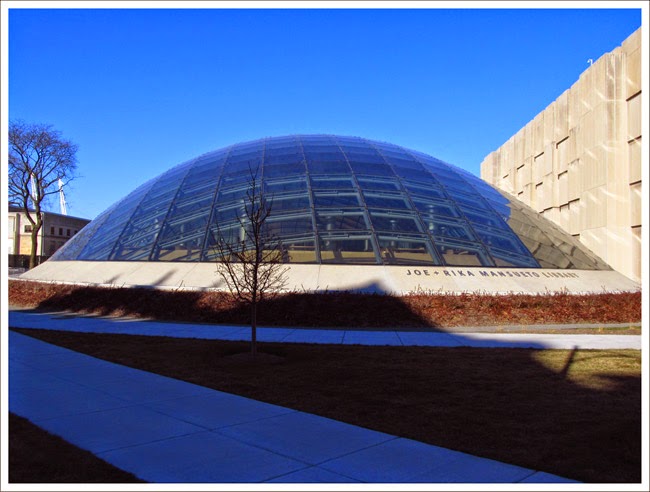Joseph Regenstein - Joe & Rika Mansueto Library Buildings
by: chicago designslinger
[Joseph Regenstein Library Building (1970) Walter A. Netsch, Skidmore Owings & Merrill. architects /Image & Artwork: chicago designslinger]
In the mid-1950s the folks who ran things at the University of Chicago decided that it was time to ditch the historic Gothic Revival style that the school had embraced since 1892 for its campus buildings, and move into the modern age. And to that end the trustees began raising money to implement a expansive building plan sans a historical revival style. By the early 60s when the decision was made to build a new library the family of Chicago industrialist Joseph Regenstein stepped-up to the plate with a cool $10 million to help finance the construction. It was the largest donation to date.
[Joseph Regenstein Library Building, 1100 E. 57th Street, Chicago /Image & Artwork: chicago designslinger]
Regenstein had taken his father's paper company and turned it into a major supplier of all manner of paper products. With that, and his venture into plastics manufacturing, he became a wealthy man. He died in 1957, and his wife Helen who oversaw the family foundation decided to make a donation to the school in 1965 in honor of her husband and to the city where his family had made its fortune. Chicago's powerhouse architectural firm of Skidmore, Owings & Merrill was brought in to design the new facility under the supervision of lead partner Walter Netsch.
[Joseph Regenstein Library Building, University of Chicago /Image & Artwork: chicago designslinger]
Netsch had come to know Helen socially, and according to an oral history he did with Chicago's Art Institute in 1995, she was instrumental in securing a number of commissions for Netsch and his firm. He had recently completed the master plan and building design for the University of Illinois' Chicago Circle Campus, and translated the architecturally Brutalist notions from that project into another form of Brutalism for the exterior of the Regenstein Library. The stark, heavy, rough-surfaced, monumental concrete forms had begun to show-up on the architectural scene in the early 1960s. Architect Paul Rudolph built a quintessential expression of Brutalism in 1958 at Yale University, and yet another fine example on the U of I campus at Urbana in 1967. Netsch on the other hand decided against using concrete for the large 4 x 8 foot exterior panels that wrapped the Regenstein project, and switched to limestone for the comb-cut, incised surface. And when the building opened in October, 1970 it was the largest structure on campus in terms of square footage.
[Joe & Rika Mansueto Library Building (2011) Helmut Jahn, Murphy/Jahn, architects/Image & Artwork: chicago designslinger]
In an era when the traditional bookstore seems to be disappearing from the planet, the Regenstein was actually running out of book space by the turn of the 21st century. Unlike many of the major universities in the country, the librarians and trustees at U of C decided not to move the massive book and manuscript collection to an off-site location, and made the commitment to somehow expand the storage space in or near Netsch's 35-year-old building. Chicago's über-architect Helmut Jahn proposed a state-of-the-art storage and book retrieval facility capped by a glass-enclosed reading room. It was going to cost money, around $80 million to be exact, but the trustees gave the okay, and two U of C alumni Morningstar, Inc. millionaires Joe and Rika Mansueto stepped-up to the plate with a $25 million donation. Below the low-slung domed structure dedicated in 2011, three levels of below-ground, climate controlled chambers hold 3 million books - with room for more.




No comments:
Post a Comment
Note: Only a member of this blog may post a comment.